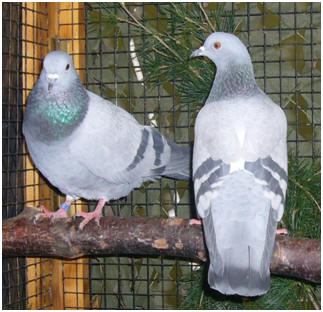|
What is the accepted
assigned genetic symbol for blue in the Domestic Pigeon?
A New
Year's surprises was that after renovation the homepage several
links to older contributions changed. That unfortunately holds also
for some links posted recently. Contributions to the use of symbols
can be found right now
http://www.taubensell.de/011_Neu_Archiv/zum_und_vom_gebrauch_von_symbole_teil1.htm
http://www.taubensell.de/011_Neu_Archiv/zum_und_vom_gebrauch_von_symbole.htm
The
reason for posting the links was the provocative questions by Ken
Davis in a Facebook group for pigeon genetics.
What is The Accepted
Assigned Genetic Symbol for Blue in the Domestic Pigeon?"
The
debate has shown that one can indeed basically agree on the state of
facts, but nevertheless can dispute long on the form, or in this
case the proper symbols to characterize the facts.
Blue
for W. F. Hollander, Joe Quinn and later authors is defined as the
reference standard, the wild-type in the appearance of the blue
black barred rock pigeon. As a symbol + is applied when it comes to
the blue-gray color, + when it comes to the bar pattern, + also,
when it comes to the featherless legs, the absence of other feather
structures etc.
The
wild-type device in our consciousness by the fact that there have
been at a specific location on a chromosome mutation as a deviation
from the wild type. W. F. Hollander has the question recorded
indirectly in a humorous fictional conversation in his 'Origins and
Excursions in Pigeon Genetics' of 1983 at p. 20f. "… Don't you talk
about a gene for recessive red, or a gene for dilution?" -"Indeed we
do. Those are units identified by being different from blue. Blue is
the wild-type, normal, standard of reference. Recessive Red or
dilution are departures, changes, single and identifiable. Many
other mutants are also known." - "Then blue isn't single and
identifiable?" - "Correct!..."
If
there is agreement on these facts, then it's all about the question
of how you can make most conveniently clear that you want to talk
about the wild-type at the locus of a specific mutant.
 |